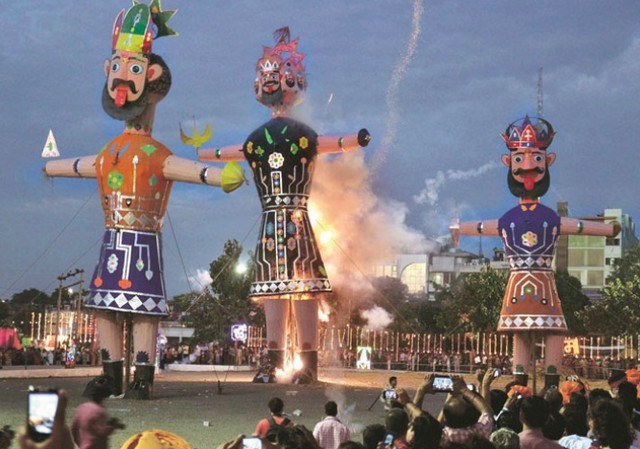India is a gigantic country with a population of more than 1.2 billion people. It is almost impossible to mention all the religious festivals. Each festival has its own history, legend and meaning. The celebrations are carefully prepared. But the Hindu festival from Dussehra to Amritsar overflowed and killed many people. We explain it to you.
Each religion in India has its own festivals
It is impossible for a tourist not to pass through a city celebrating a god or other deities. For example, the dates of « Hindu festivals » are set according to the lunar calendar, which depends on the movements of the sun and moon throughout the year.
Some Hindu festivals are celebrated as historical mythology, others due to seasonal changes…
Muslims are not to be outdone. There are many religious holidays that they celebrate with passion and dedication following the date of their Islamic calendar…
 Sikh people organize many unique festivals and rituals that they celebrate with great enthusiasm and joy. They commemorate the lives of their 10 Sikh gurus, including their teachings.
Sikh people organize many unique festivals and rituals that they celebrate with great enthusiasm and joy. They commemorate the lives of their 10 Sikh gurus, including their teachings.
People of the « Jain » religion have many religious rituals and ceremonies to celebrate. Their rituals belong to the cults of idols in various ways and festivals belong to the events of Tirthankara’s life that involve the purification of the soul.
People of the Christian religion celebrate their holidays such as Christmas, Easter, Good Friday, etc. with great enthusiasm. We will not forget the people of Buddhist religion who celebrate their festivals related to Buddha and Bodhisattvas. Buddhists have their own beliefs and rituals for celebrating historical festivals.
Amritsar was the scene of an important Hindu festival
 The inhabitants of Amritsar, a city in northern India, were preparing for the Hindu festival in Dussehra. It is one of the most important festivals for Hindus.
The inhabitants of Amritsar, a city in northern India, were preparing for the Hindu festival in Dussehra. It is one of the most important festivals for Hindus.
The highest point of Dussehra is a procession of giant effigies, some reaching up to 20 metres, representing characters from Hindu mythology.
The latter were to be burned during the festivities. As the fire of the effigies is supposed to symbolize the dissipation of evil. Sometimes effigies represent politicians, especially Pakistani politicians!
Amritsar is in mourning
This city in northern India is known as a Sikh religious centre. But many Sikhs join this Dussehra festival alongside the Hindus. In general, this celebration attracts at least 50,000 people. However, for reasons still unexplained, fireworks were launched, particularly near railway lines.
 Many people had invaded the rails looking at the fire of the effigy of the demon Ravana during the festival. Two fast trains would have arrived at the same time and without warning. More than 50 people are reported to have died.
Many people had invaded the rails looking at the fire of the effigy of the demon Ravana during the festival. Two fast trains would have arrived at the same time and without warning. More than 50 people are reported to have died.
Indians always cross railway tracks
The images we all have in mind are slow-moving trains overflowing with passengers. Some of them grab onto the roofs of the cars. In the early 2010’s, about 6,000 people lost their lives on the crowded Mumbai suburban rail network alone.
In addition, about a thousand people died as a result of overcrowding, train collisions or derailments. This is gradually being resolved through the modernization of the rail network and the arrival of high-speed trains.
Railways would have been notified
 Navjot Kaur Siddhu, a politician from the local Congress party who was the main guest at the religious ceremony, said that the celebrations take place in the region every year and that railway authorities were advised to run low-speed trains. This was not the case. An investigation is ongoing.
Navjot Kaur Siddhu, a politician from the local Congress party who was the main guest at the religious ceremony, said that the celebrations take place in the region every year and that railway authorities were advised to run low-speed trains. This was not the case. An investigation is ongoing.
Railways are faster than in the past
Indian railways have progressed like many other areas. The trains are faster. The Spanish are testing the Talgo, between Delhi and Mumbai, with a top speed of 150 km/h.
According to information, 800 TGV trains will be manufactured for the Indian rail network over the next 11 years as part of a joint venture with Alstom. Indian Prime Minister Narendra Modi and his Japanese counterpart Shinzo Abe recently laid the foundation stone for the Ahmedabad-Mumbai high-speed train project in Gujarat. The Mumbai high-speed train project in Ahmedabad will be based on Japan’s Shinkansen.
It is to be hoped that these lines will be protected and that regular information will be provided to the public. Habits are hard to break.
Serge Fabre